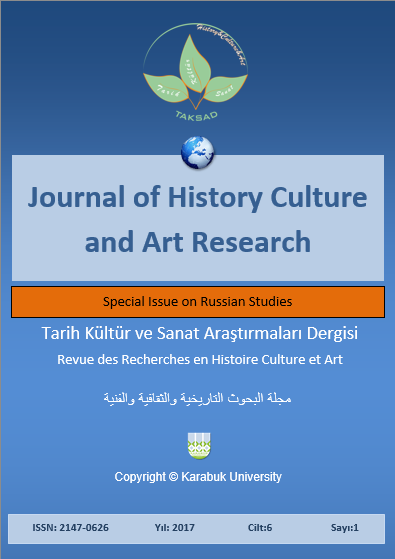Images of History through the Prism of National Consciousness
DOI:
https://doi.org/10.7596/taksad.v6i5.1303Anahtar Kelimeler:
Image- History- Ethnos- Functions- Objective- Subjective- Historical memory.Özet
One’s people history is one of the most important sources that reproduce resources for the formation of ethnic subjectness. An appeal to history is accompanied by the formation of a certain image, both of a given ethnic community and of its historical development. Reconstruction of the experience of the previous development of an ethnos is accompanied by the construction of a special discourse in which the ethnic characteristics of this community, the system of its values, all the events of its historical past, often begin to be determined by subjective modality. The latter in its turn is determined by a variety of functions needed within the given discourse to construct this image. The image of history of people existing in the national consciousness, representing a unity of the objective and subjective, can also be viewed as a unity of continuity and, at the same time, development of the self-consciousness of the ethnos, since the past and history are the most important conditions for construction of the present and the future of the nation. The image of the history of a given nation existing in the national consciousness, representing a unity of the objective and subjective, can also be viewed as the unity of continuity and at the same time as the development of the self-consciousness of the ethnos, since the past and history are the most important conditions for the construction of the present and the future of the nation. Reproducing the national memory in the image of history, the ethnic community preserves the core of its culture, its spiritual wealth and at the same time creates internal sources of dynamics for its further development. At the same time, the image of history performs various functions in the structure of the national consciousness.
Referanslar
Andreev, A. (1996). Ethnic revolution and reconstruction of the post-Soviet space. HE IS WITH, 1. URL: http://www.smolsoc.ru/index.php/2010-09-06-18-22-12
Barth, F. (2006). Ethnic groups and social boundaries. The social organization of cultural differences. Collection of articles, (pp. 15-19). Translated by I. Pilitsikova. Moscow: New publishing house.
Dragunsky, D. V. (1995). Ethnopolitical processes in the post-Soviet space and reconstruction of Northern Eurasia. Polis, 3.
Eller, J. D. (1997). Ethnicity, Culture, and "The Past". Michigan Quarterly Review. 36(4). URL: http://hdl.handle.net/2027/spo.act2080.0036.411
Gizatova, G. K. & Ivanova, O. G. (2013). Transformation of subjectivity in a modern multicultural society. Bulletin of the Russian Nation, 5, 104-120.
Jameson, F. (1982). The Political Unconscious: Narrative as a Socially Symbolic Act. Cornell University Press.
Jaspers, K. (1994). The meaning and purpose of history. Moscow.
Kunczik, M. (2001). Globalization: News media, images of Nations and the flow of international capital with special reference to the role of rating agencies. IAMCR Conference, Singapure. URL: https://www.files.ethz.ch/isn/46966/2001-02-Globalization.pdf
Markov, B. (1999). Temple and the market. Man in the space of culture. Saint Petersburg: Aleteyya Publishing House.
Rüsen, J. (ed.) (2007). Meaning and Representation in History. New York: Berghahn.
White, H. (1984). The Question of Narrative in Contemporary Historical Theory. History and Theory, 23(1), 1-33. URL: http://culturahistorica.es/hayden_white/narrative.pdf
İndir
Yayınlanmış
Nasıl Atıf Yapılır
Sayı
Bölüm
Lisans
Tarih Kültür ve Sanat Araştırmaları Dergisi'nde yayımlanan tüm çalışmalar Creative Commons 4.0 CC-BY lisansı ile lisanslanmıştır.
Bunları yapmakta özgürsünüz:
- Bu eseri her boyut ve formatta paylaşabilir — kopyalayabilir ve çoğaltabilirsiniz.
- Materyalden Adapte et — karıştır, aktar ve eserin üzerine inşa et
- her türlü amaç için, ticari amaç da dahil
Alttaki şartlar altında:
Atıf — uygun bilgiyi, lisansa linki, and ve değişiklik yapıldıysa değişiklik bilgisinivermelisiniz. Sizi veya kullanımınızı lisansörün onayladığı bilgisini içermemek kaydıyla, size uygun şekilde bu işlemleri gerçekleştirebilirsiniz.
AynıLisanslaPaylaş — Eğer materyali karıştırdınızsa, aktardınızsa ya da materyalin üzerine çalıştınızsa, ancak aynı lisans ile dağıtabilirsiniz.
- Ek sınırlamalar yoktur — Lisansın izin verdiği hakları başkaları üzerinde kanunlarla ya da teknolojiyikullanarak sınırlayamazsınız.







